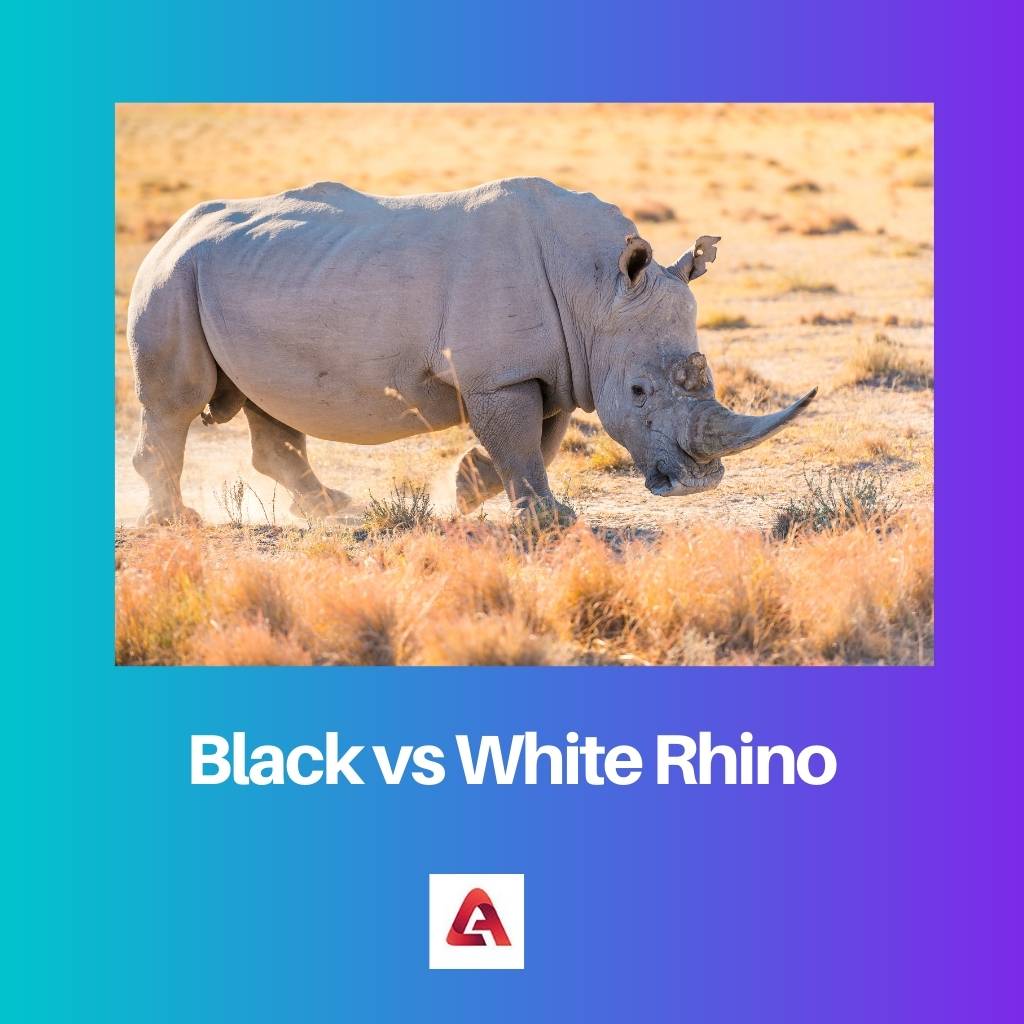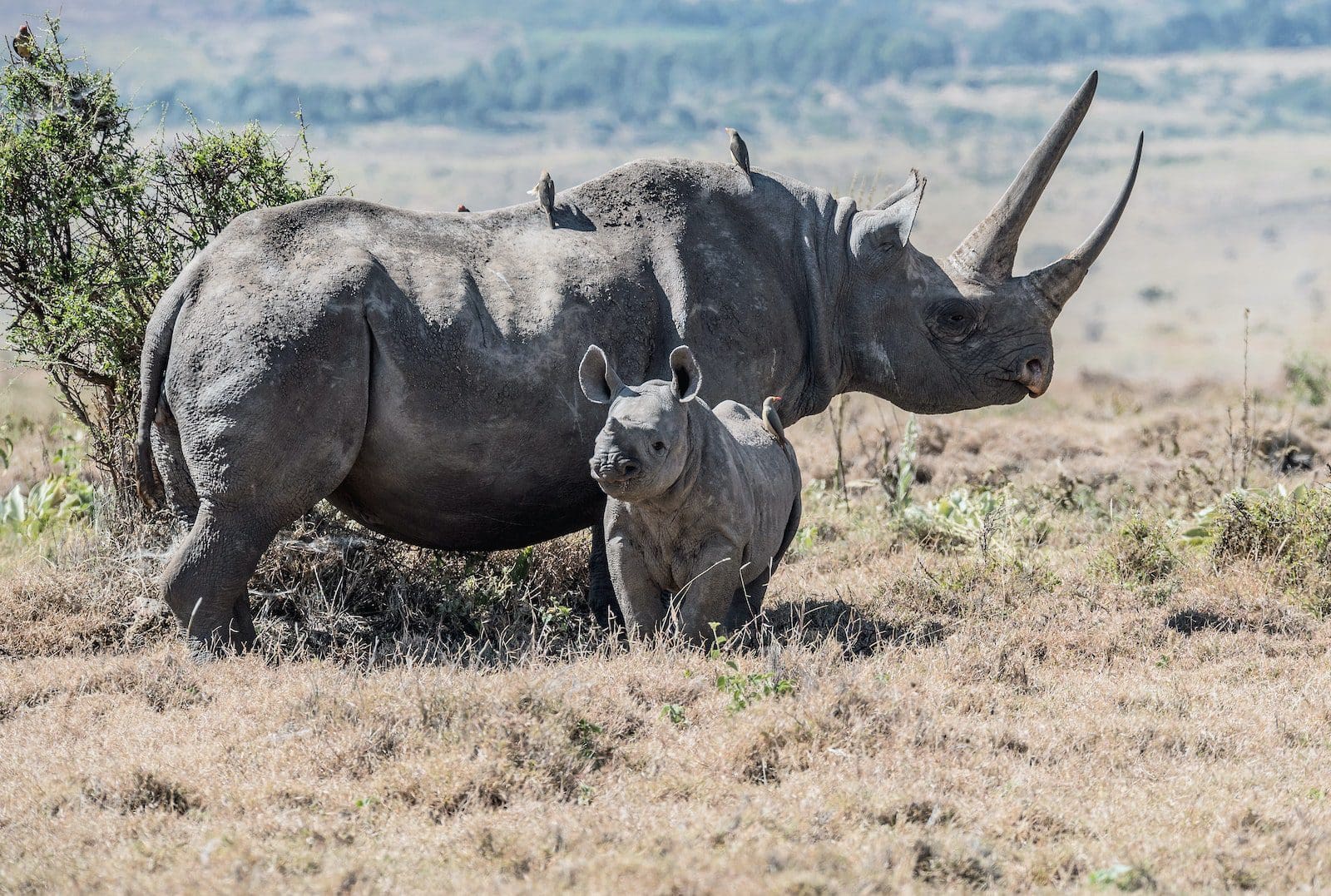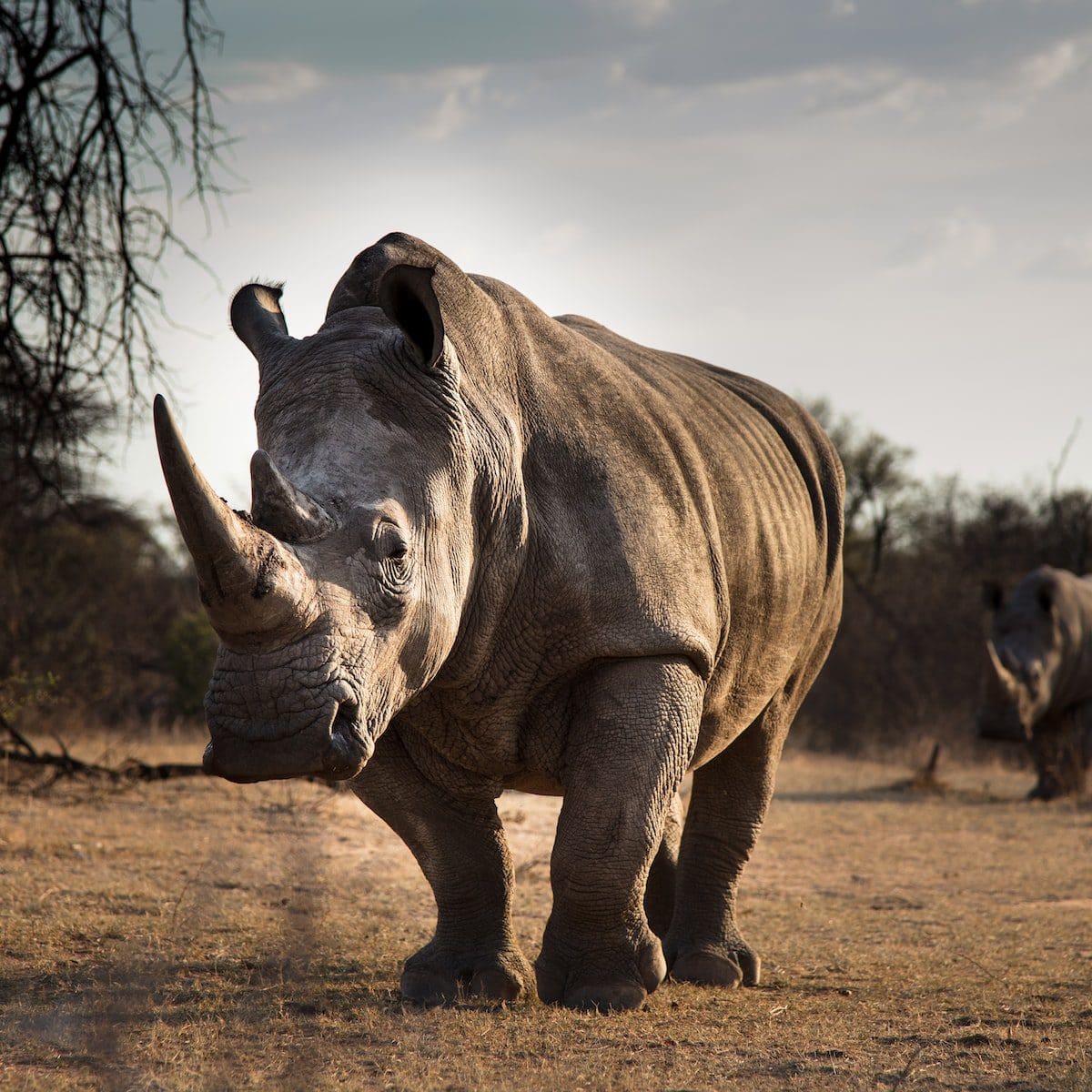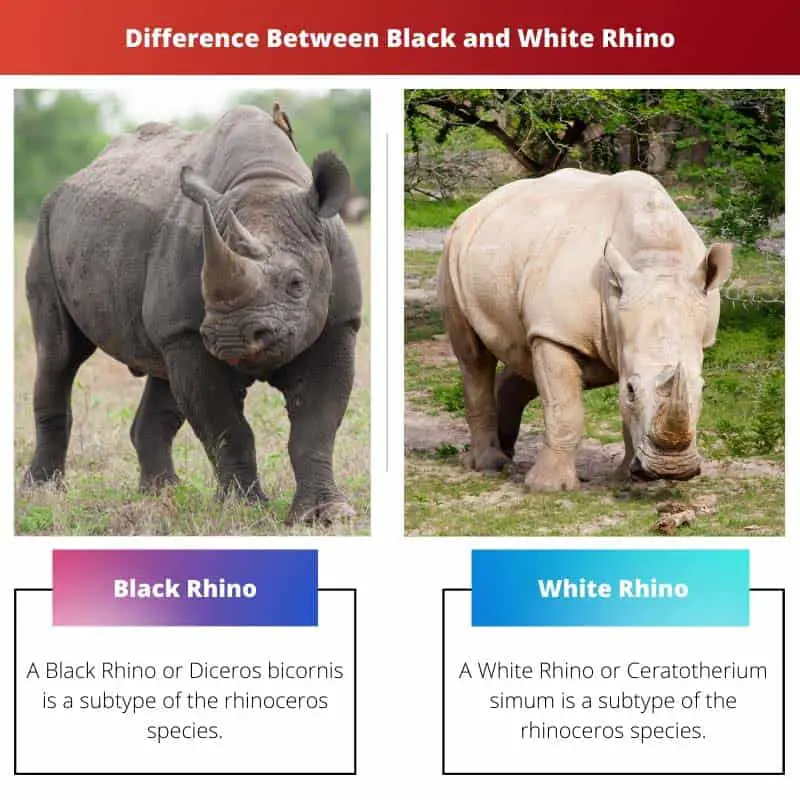The rhinoceros or commonly called the rhino is one of the largest and heaviest land mammals present on Earth. They belong to the Order Perissodactyla, which means they are odd-toed.
They are ungulates and presently are threatened species on the planet, with only five extant species.
Key Takeaways
- Black rhinos have hooked, pointed upper lips, while white rhinos have wide, square-shaped lips.
- Black rhinos are smaller and more aggressive than white rhinos.
- White rhinos graze on grass, while black rhinos browse on bushes and trees.
Black vs White Rhino
The difference between Black and White rhinos lies in their physical appearance and geographical extent of habitat. Black Rhinos differ from White Rhinos in their size, head and face shape, shoulder hump, lips, and horns. Black rhinos are found in comparatively smaller geographical areas than their counterpart, the White Rhinos.

Diceros bicornis is the scientific name of the heavy terrestrial mammal, the Black Rhinoceros. The Black Rhinoceros is a critically endangered species native to Africa.
They are dark-skinned, heavy mammals with hook lips. Their head is smaller, resting on humpless shoulders.
They have a smaller stature with a compactly built body.
Ceratotherium simum is the scientific name of the heavy terrestrial mammal, the White Rhinoceros. The White Rhinoceros, a nearly endangered species, are also native to Africa.
They are also dark-skinned however are found bathed in mud that dries off their skin to give a white appearance. They are heavier, and have larger heads that rest on humped shoulders.
They have a larger stature with a square-shaped lip.
Comparison Table
| Parameters of Comparison | Black Rhino | White Rhino |
|---|---|---|
| Colour | They are dark greyish to brown. | They have similar skin colours but are mostly found with mud covering. |
| Height | They are 4.5 -5.5 inches in height up to the shoulder. | They are 5 – 6 inches in height up to the shoulder. |
| Weight | Black Rhinos weigh from 800 to 1400 Kg. | White Rhinos weigh around 1700 Kgs (Female) or 2300 Kgs (Male). |
| L.ips | Black Rhinos have lips used for browsing food. That is, they have pointed upper lips. | White Rhinos have lips used for grazing. That is, they have square lips. |
| Head | Black Rhinos have a protruding head with a smaller forehead. | White Rhinos have longer skulls than Black Rhinos and tend to keep their heads closer to the ground. |
| Hump | Black Rhinos have a smaller sacral hump on their shoulder. | White Rhinos have a large sacral hump to hold their larger heads, |
| Ears | Black Rhinos have smaller curved ears. | White Rhinos have larger, long pointed ears. |
| Track | The size of the track is 20 – 28 cm. | The size of the track is 20 – 25 cm. |
| Horn | They have two horns of almost equal length. | They have two horns, with the front one being longer. |
| Dung | A Black Rhinos’ dung is lighter in colour due to its varied food habits. | A White Rhinos dung is darker in colour due to its varied food habits. |
| Behaviour | Black Rhinos are more curious and aggressive | White Rhinos are less curious and aggressive. |
| Habitat | Black Rhinos are found near bushy areas. | White Rhinos are found near grassland. |
What is Black Rhino?
A Black Rhino or Diceros bicornis is a subtype of the rhinoceros species. It is a large land mammal and is a herbivore.
It has a dark greyish skin color and a very thick armor-like skin which is almost inflexible.
It naturally feeds on twigs and leaves of bushes and hence holds its head high above the ground. The head is smaller, and the shoulder hump supporting the head is thus smaller.
The heads bear two close sets of small ears, eyes, and pointed hook-shaped lips. The hooked-shaped lips help them in pulling their food from the plants.
They flaunt two horns on their head of almost equal length, which are a target for poachers. Their foot tracks are narrower but longer than the White Rhino.
Black Rhinos also tend to be very protective of their children and take care of them for longer periods than White Rhinos.
It is very heavy (800-1400kg) and long-lived (40 years) animals. The only terrestrial animal heavier is the elephant. They are naturally more curious and aggressive and live alone.
They are a critically endangered species, with only around 5000 of them alive today in their natural tropical and sub-tropical grassland habitats of Africa.

What is White Rhino?
A White Rhino or Ceratotherium simum is a subtype of the rhinoceros species. It is a larger mammal and is also a herbivore.
It has dark greyish skin that is camouflaged with the mud it bathes in, giving it a whitish appearance. The skin is thick but comparatively loosely covering the body than the Black Rhino.
IT naturally feeds on ground grass, due to which its head is always hanging down. To support this head, it has a large shoulder hump.
The head is longer and narrower than a Black Rhino. The head bears two largely spaced narrow pointed ears, eyes, and square-shaped lips. The shape of the lips aids the animals in their grazing habit.
They flaunt two horns on their head. The front horn is longer than the one behind it. These horns are an attraction for poachers.
Their foot tracks are broader and smaller than Black Rhinos.
White Rhinos tend to be very protective of their young, only up till a certain point, after which they leave them to survive on their own.
They are a nearly threatened species, with around 17000 of them found in the wild. They are very heavy and even surpass the weight of the Black Rhino.
They are more sociable animals and show less aggression toward other beings. They are found in the grassland and savannas of Africa.

Main Differences Between Black and White Rhino
- Black Rhinos are smaller and lighter than their larger and heavier relative, the White Rhino.
- Black Rhinos have smaller heads and humps due to their browsing habits, while White Rhinos have larger heads and humps due to their ground grazing habits.
- The lips of a Black Rhino are shaped like a hook, while that of a White Rhino is broader and square-shaped.
- Black Rhinos have two horns on their head, but their second horn is much longer than the second horn of a White rhino.
- Black Rhinos feed on twigs, leaves, branches, grass, etc. Because of this, their dung has a mixed brownish color, while the dung of grass-eating White Rhino is black, is due to the high melanin in the grass.
- Black Rhino is rarer than White Rhino.
- Black Rhino are found to a lesser geographical extent in comparison to the widely distributed White Rhino.





